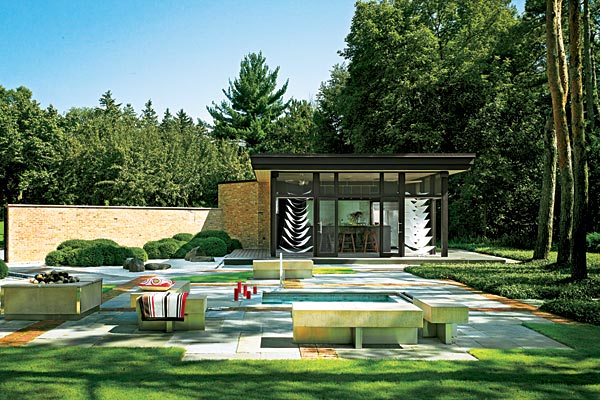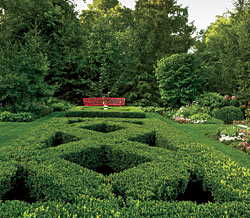
The four-acre property includes seven gardens, three of which have Asian elements, including the pavilion shown here. The garden styles are visually united through the use of boxwoods in different forms and a brick pattern in the bluestone pavement. Photo Gallery »
It’s hard to believe that the luscious pavilion, spa, and gardens that Julie Rearick and Associates, along with Rocco Fiore & Sons Landscaping, created for this Lake Forest estate cover grounds that were once a swampy eyesore. If we may exaggerate a bit, it’s like Peter the Great transforming a sloppy Russian backwater into St. Petersburg. But while Peter’s city was conceived as a “window to the West,” the vision of Rearick et al. was more East-meets-West, an impressive bridging of modern and traditional, Zen and formal.
After completely gutting and decorating her clients’ house, Rearick, an interior designer, took on the formidable project of redoing its four acres of grounds. Working with her brother, the architect Rick Rearick (an associate at her firm), and Fiore’s award-winning team, she oversaw a multistage process that started with traditional English-style gardens and the area surrounding the Olympic-sized pool. It ultimately included her solution for an “unmanicured, tired area of weeds and overgrown wildflowers” between the 1960s-era main house and two David Adler–designed pool houses—a large open plaza that the owners could use for cooking, entertaining, and dreamily gazing upon from their back porch.

The formal English garden just behind the minimalist Japanese one feels almost like a different world. Anchored by a red bench against a majestic backdrop of Norway spruce, this formal parterre area is planted with lavender, wave petunia, cosmos, verbena, and dianthus. Photo Gallery »
What the expanse needed, first and foremost, was an anchor; Rearick proposed an open-sided pavilion that would be a modern take on a Japanese temple. The simple structure—reminiscent of Mies Van Der Rohe’s Farnsworth House—contains a full kitchen customized to operate year-round. “There is no glass between those steel beams,” says Rearick. So every material, from the stainless steel cabinets to the black-painted stucco on the walls and face of the island, was chosen to withstand subzero temperatures. (The refrigerator and water are turned off in winter.) In case her clients someday decide to install windows, Rearick outfitted the space with heating and air conditioning.
The quest for all-season usability didn’t end there. Rearick had radiant heating installed beneath paved walkways throughout the grounds not only so snow would quickly melt in the winter but also so the owners could use their outdoor spa any time; the sunken hot tub and stone-and-stainless-steel benches surrounding it can all be heated. A stone structure around the gas fire pit has edges wide enough to be used as seating.
No detail was overlooked in the carefully wrought design. Rust-colored brick inlays in the bluestone pavement make a crucial visual connection between the hardscaping and the brick-and-stone Adler pool houses; the striking grid design in the pavers is an homage to the late architect’s own famous patterned exteriors. On one side of the pavilion, a Japanese garden of delicate white pebbles with ground-hugging shrubs and large black stones makes for another pleasing contrast, of dark and light.
An even bigger contrast is revealed farther out on the grounds, where more traditional gardens are located. The size of this property allows for a rose garden, elegant boxwood groupings with benches and sculptures, and woodsy areas of mature Scotch pines. Rearick and Fiore were determined to make the property look its best, no matter the weather. While Fiore and his team worked their magic on the plantings, Rearick dreamed up the cherries on top: two long, elegant, curved red steel benches.
“In winter, they look pretty against the white snow; in the summer, they blend with the roses; and in the fall, they complement the autumn colors,” says Rearick. “We made sure the view outside the window was beautiful year-round.”
Photography: Nathan Kirkman
Styling: Diane Ewing
Related:
Buy Guide
ABOUT OUR SOURCES: We attempt to provide as much information as possible about the products and professionals involved in designing the homes we show in our pages. Items not sourced here are probably not available for sale; they might be antiques or part of an owner’s personal collection. When an item or product line is widely available, we may not list a specific store for it. If you have a question about our sources, please write to us at chicagohome@chicagomag.com.
Design, construction, and architecture: Julie Rearick & Associates, 847-269-1958; julierearick.com. Landscape: Rocco Fiore & Sons, 28270 N. Bradley Rd., Libertyville, 847-680-1207; roccofiore.com. Red bench, designed by Rearick & Associates, fabricated by McKinnon and Harris, mckinnonharris.com. Kitchen: Stools, Pagoda Red, 1714 N. Damen Ave., 773-235-1188, pagodared.com. Light fixtures above island, Juno Lighting; Louis Poulsen sconce, both at Lightology, 215 W. Chicago Ave., 312-944-1000, lightology.com. White paper sculpture by Kyoko Ibe, available through Rearick & Associates.



